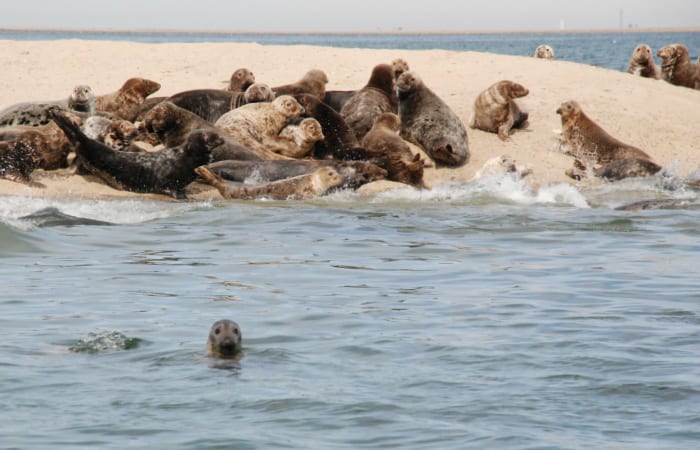
Seals “haul out” on Cape beaches, leaving the water to mate, give birth, avoid predators, rest, or warm up.
(Jim Canavan/WHOI)The Return of the Seals
Growing Herds Raise Questions on Sharks, Fish, and Poop
There was once a bounty on gray seals in New England; hunters in Massachusetts and Maine got $5 if they turned in a nose or skin. From the 1890s until the 1960s, an estimated 135,000 seals were killed, and seals disappeared from Cape Cod.
Then the federal Marine Mammal Protection Act of 1972 outlawed seal killing. Gradually the seal population recovered and is now thriving. A 1994 survey spotted 2,035 seals in Cape Cod waters; by 2011, the National Marine Fisheries Service counted more than 15,700, with hundreds regularly seen congregating on beaches, or “hauling out,” on the Cape shoreline.
The population of humans has also flourished. Never in their lifetimes had they encountered seals restored to pre-hunting levels. Perhaps inevitably, conflicts have ensued. In recent years, people have complained that the growing seal herds are attracting great white sharks to Cape Cod waters, eating fish that fishermen hoped to catch, and polluting beaches with seal feces. In 2011, five seals on Cape Cod were found shot in the head.
To help address these concerns, a group of scientists, fishers, and resource managers created the Northwest Atlantic Seal Consortium in 2012. Its goal is to get and share knowledge on the ecological role of seals in the northeastern United States: how they live, where they go, what they eat, their health and illnesses, and their interactions with the world—including humans—around them.
In an initial effort, Woods Hole Oceanographic Institution biologist Rebecca Gast investigated the claim that seal poop may be contaminating water off Cape Cod beaches.
“As far as I know, no one had looked at the data to ask these questions before,” Gast said. She and colleagues examined water quality data routinely collected by the Massachusetts Department of Public Health from 89 public beaches between 2003 and 2012. The sites included beaches in six towns near where seals haul out: Provincetown, Truro, Wellfleet, Eastham, Orleans, and Chatham.
In particular, she examined how many times levels of bacteria associated with fecal contamination exceeded limits for public health and triggered beach closures.
“Our analysis of 10 years of data shows there was no change in the trend of water quality exceedances for the region,” Gast said.
Looking more closely at the beaches closest to large seal haul-outs, the researchers found that beaches within five miles of the haul-outs actually showed a slight decreasing trend in contamination incidences and beach closures over the past decade, while the beaches more than five miles away from seal haul-outs showed a slight increasing trend in beach closures.
“The evidence indicates that at this time, the water quality at beaches near large seal haul-outs is not worse than at beaches without large numbers of seals nearby,” Gast concluded. “In fact, four of the five beaches in Chatham Harbor that are close to the seal haul-outs have never had an exceedance event.”
Related Articles
- The ocean currents behind Brazil’s pollution problem
- How is human health impacted by marine plastics?
- Sunlight and the fate of oil at sea
- A toxic double whammy for sea anemones
- WHOI scientists discuss the chemistry behind Sri Lanka’s flaming plastic spill
- Oil spill response beneath the ice
- Fukushima and the Ocean: A decade of disaster response
- WHOI scientist shares her perspective on ‘imminent’ oil spill in the Red Sea
- WHOI establishes new fund to accelerate microplastics innovation
Featured Researchers
See Also
- Northwest Atlantic Seal Research Consortium The Northwest Atlantic Seal Research Consortium (NASRC) seeks to improve understanding of the ecological role of seals in the northeast U.S. through research, data sharing, collaboration among stakeholders, and public outreach
- Massachusetts Department of Public Health, State Beaches Water Quality Data Water quality data for state beaches
- Testing the Waters and Closing Beaches Oceanus story about work by Elizabeth Halliday, Rebecca Gast's student, on bacterial contamination of beaches
- Rebecca Gast's laboratory pages Rebecca Gast's research

